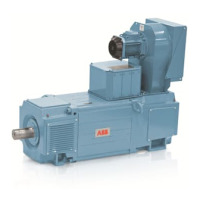23
General
Commutator
Under normal operating conditions the
commutator does not require any special
maintenance.
If the commutator surface is rough, it is
essential to check the operating conditions
such as current loading, and environmental
conditions. See the chapter “Brushes and
commutation”.
The action to be taken in the event of a defect
arising from the commutator must be deter-
mined from case to case. Only general advice
can be given.
Corrosive
environment
Inspect the commutator surface before start-up
to see if the machine has been exposed to cor
-
rosive gases. If this has happened, remove the
coating with fine emery cloth, a rubber polishing
block or fine stone.
Commutator
out of true
If the commutator is badly out of true (brush
chatter) or if strong burn marks are evident,
the commutator may have to be skimmed with
a grinder or be carbide/diamond-turned on a
lathe. Centring of The axis must be centred with
reference to the bearing seats.
Roundness is very important. The total indicator
reading (TIR), on a newly-turned commutator
must not exceed 0.020 mm.
In addition, there is also a requirement that the
difference in radius from one lamination to the
next must not exceed 0.004 mm.
The surface roughness should be R
a
=1.6 µm.
After skimming, the segment insulation may
have to be undercut according to the figure be-
low. The insulation must be cut back far enough
so that chamfering is possible.
Type Commutator diameter, D (mm)
DMI New Min Depth of wear
180 178 170 4
200 178 170 4
225 235 225 5
250 265 255 5
280 265 255 5
315 330 318 6
400 414 402 6
Fig 14 Turning down dimensions.
Fig 15 Cutting tool for turning.
The distance between the brush holder and the
commutator surface should be 2.5 ±0.5 mm. If
the distance has become larger after turning of
the commutator, the brush holder must be reset.
If the defects are slight, fine emery cloth or
rubber polishing block should be tried first so as
not to remove more of the patina than necessary.
If the patina is of poor quality, ABB recommends
removing it completely.
If the surface is burnt to the extent that craters
have appeared, an abrasive cloth or fine grind-
stone may be used, but great care must be
taken to avoid short-circuits at the laminations.
Grinding should be done at reduced voltage.
D
MIN
Fig 16 The segment insulation must
be undercut to a depth of
1.25 ± 0.45 mm.

